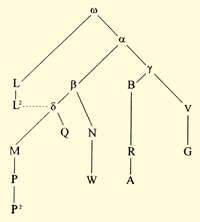As with all other ancient literary works, the goal of editorial work on medical texts is that the published text should approximate as nearly as possible the original text, in keeping with the author’s intentions. This presupposes a critical examination of all textual sources belonging to the tradition, tracing back to the time of the earliest extant source for the text in question.

The majority of the surviving sources for medical texts are medieval manuscripts, most of which date from the period between the 12th and 16th century, although some can be traced back to the 10th century and, in one case, to the 6th century. It follows that, even under the most favourable circumstances, hundreds of years elapsed between the writing of the extant manuscripts and the composing of the originals, during which time the texts underwent modification. Because the texts in question were medical works intended for use by physicians, the modifications were not limited to standard copying mistakes (slips of the pen, word substitutions, omissions, additions and transposition of words), but also included deliberate tampering with the text for the purpose of updating the factual content.
Apart from manuscripts, the medical textual tradition includes excerpts contained in the writings of later authors, and especially, in the case of Greek texts, translations into Latin, made in late antiquity, as well as translations into Arabic and Hebrew. These often prove particularly valuable, because they represent traditional material that is chronologically prior to the material presented in the manuscripts. To a lesser extent, papyri containing brief fragments of text worthy of consideration have also survived. Also deserving of text-critical evaluation are the Latin translations of Greek texts executed during the Middle Ages and the humanistic period, early printed editions, and all subsequent editions.
Editorial work begins with the collation of all surviving manuscripts containing a given text. Through subsequent critical comparison of the various readings, the relationship between the codices is determined.

That several manuscripts are related can be established because of the occurrence of identical errors. These lead to the conclusion that the text of a more recent manuscript from a given group can be traced either directly or indirectly to an older representative of the same group, or that both manuscripts, independently of one another, reproduce the same error contained in a common exemplar that has either survived or has to be conjectured. Otherwise, it may happen that other manuscripts are correct in this passage, thus providing a criterion for concluding that they are independent of the aforementioned group. This process leads gradually to the determination of the independent sources, which are relevant to the establishment of the text. The greater the number of independent manuscripts, the sooner it becomes possible to recognize their textual differences as errors and to determine the original wording. The relationships between the manuscripts can be illustrated via a stemma (“genealogical tree”). This graphical representation is - especially in the case of complicated dependency relationships - an essential aid in orienting not only the reader of an edition, but the editor as well.
The version of the text derived from comparison of codices is itself subject to corruptions which have arisen prior to the extant manuscripts. It is the responsibility of the editor to identify and, where possible, to emend these corruptions. The fact that a passage is corrupt can be determined, among other things, from the presence of linguistic and factual inconsistencies. To recognize and eliminate these inconsistencies, the editor must be familiar with the author’s language and his ideas. Clues to emendations may at times be found in witnesses of the indirect tradition, excerpts, translations and papyri. If a corrupted passage cannot be corrected, this fact is indicated in the text through the use of text-critical symbols.
Text: J. Kollesch, D. Nickel; Translation: J. Crone
cf. Brochure of Corpus Medicorum Graecorum / Latinorum, Berlin 2004
(c) BBAW